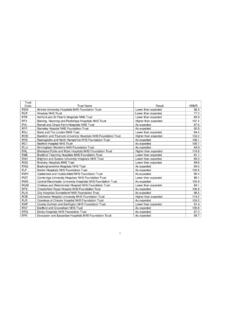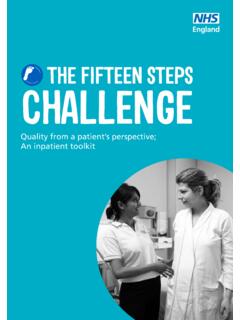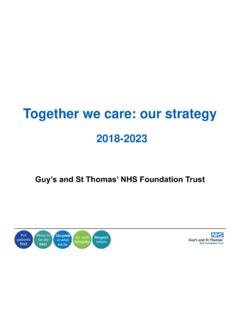Transcription of Emergency healthcare workers, exposure prone procedures ...
1 Emergency healthcare Workers, exposure prone procedures Emergency healthcare Workers, exposure prone procedures (EPPs) and the exposure prone Environment Advice from the United Kingdom Advisory Panel for healthcare Workers Infected with Bloodborne Viruses (UKAP) Emergency healthcare Workers, exposure prone procedures (EPPs) and the exposure prone Environment 2 About Public Health England Public Health England exists to protect and improve the nation s health and wellbeing, and reduce health inequalities. We do this through world-class science, knowledge and intelligence, advocacy, partnerships and the delivery of specialist public health services. We are an executive agency of the Department of Health, and are a distinct delivery organisation with operational autonomy to advise and support government, local authorities and the NHS in a professionally independent manner.
2 Public Health England Wellington House 133-155 Waterloo Road London SE1 8UG Tel: 020 7654 8000 Twitter: @PHE_uk Facebook: Crown copyright 2017. You may re-use this information (excluding logos) free of charge in any format or medium, under the terms of the Open Government Licence To view this licence, visit OGL or email Where we have identified any third party copyright information you will need to obtain permission from the copyright holders concerned. Published April 2017 PHE publications PHE supports the UN gateway number: 2017018 Sustainable Development Goals Emergency healthcare Workers, exposure prone procedures (EPPs) and the exposure prone Environment 3 Contents Acknowledgements 4 Executive Summary 5 exposure prone procedures (EPPs) 6 Table 1: Emergency HCW categorisation 8 Box 1: Examples of potential EPPs that may be undertaken outside a hospitaly 9 Background 10 Management of risk of nosocomial infection out of hospital 12 Emergency healthcare Workers, exposure prone procedures (EPPs) and the exposure prone Environment 4 Acknowledgements On behalf of the UK Advisory Panel for healthcare Workers Infected with Bloodborne Viruses (UKAP), this document was prepared by.
3 Dr Roger Cooke, Consultant in Occupational Medicine and Pre- hospital Emergency Care Doctor Dr Monica Desai, Consultant Epidemiologist and UKAP Medical Secretary 2016 to 2017, PHE Dr Wendy Matthews, Consultant in Emergency Medicine, Imperial College healthcare nhs trust Dr Fortune Ncube, Consultant Epidemiologist and UKAP Medical Secretary 2003 to 2016, PHE Ms Charlotte O Halloran, Surveillance Scientist and UKAP Senior Administrator, PHE And endorsed by: The royal College of Emergency Medicine Faculty of Pre- hospital Care, The royal College of Surgeons of Edinburgh College of Paramedics For queries relating to this document, please contact: the UKAP Secretariat at or on 0208 327 6074 or 0208 327 6423. Emergency healthcare Workers, exposure prone procedures (EPPs) and the exposure prone Environment 5 Executive Summary This paper summarises the background and recommendations by the United Kingdom Advisory Panel on Blood Borne Viruses in healthcare Workers (UKAP), of the categorisation of procedures performed and of the role of bloodborne virus (BBV) iatrogenic transmissions by infected healthcare workers (HCWs) in the Emergency response setting.
4 The concept of the exposure prone environment is introduced along with a classification of Emergency HCWs that facilitates the risk assessment process. This guidance document was developed over many years; the need was identified because practice in the field of Emergency medicine and pre- hospital care has become more complex with potential for exposure prone procedures (EPPs) to be carried out by a variety of staff with different governing bodies. The guidance was produced by a UKAP expert subgroup which included representatives from ambulance services and Emergency medicine and was informed by a survey audit of ambulance services that collected information on the range and frequency of EPPs undertaken by staff and reported injuries The aim of the guidance is to support trusts in undertaking their own risk assessment and planning the protective equipment and processes that need to be considered.
5 The guidance is not prescriptive but represents consensus of the multi-professional group. UKAP recommends that each ambulance service identify a lead for EPP roles so that staff and managers can direct enquiries to these relevant experts in their service In any case of uncertainty about any of the classifications or procedures listed here, or anything that has not been included, please contact the UKAP Secretariat for guidance at Emergency healthcare Workers, exposure prone procedures (EPPs) and the exposure prone Environment 6 exposure prone procedures (EPPs) Provided appropriate infection prevention and control precautions are adhered to scrupulously at all times, the majority of clinical procedures (including many which are invasive) in the healthcare setting pose no risk of transmission of BBVs from an infected HCW to a patient, and can be safely performed.
6 Those procedures where an opportunity for HCW-to-patient transmission of BBV does exist are described as exposure prone , where injury to the HCW could result in the worker s blood contaminating the patient s open tissues. This is described as bleed-back . The majority of HCWs do not perform EPPs. EPPs include procedures where the worker s gloved hands may be in contact with sharp instruments, needle tips or sharp tissues inside a patient s open body cavity, wound or confined anatomical space, where the hands or fingertips may not be completely visible at all times. However other situations, such as pre- hospital trauma care, should be avoided by HCWs restricted from performing EPPs, as they could also result in the exposure of the patient s open tissues to the blood of the worker.
7 The definition of EPPs given above embraces a wide range of procedures , in which there may be very different levels of risk of bleed-back. A risk-based categorisation of clinical procedures has been developed, including procedures where there is negligible risk of bleed-back (non-EPP) and three categories of EPPs with increasing risk of bleed-back. The definitions and examples of categories 1, 2 and 3 are: Category 1 procedures where the hands and fingertips of the worker are usually visible and outside the body most of the time and the possibility of injury to the worker s gloved hands from sharp instruments and/or tissues is slight. This means that the risk of the HCW bleeding into a patient s open tissues should be remote. Category 2 procedures where the fingertips may not be visible at all times but injury to the worker s gloved hands from sharp instruments and/or tissues are unlikely.
8 If injury occurs it is likely to be noticed and acted upon quickly to avoid the HCW s blood contaminating a patient s open tissues. Emergency healthcare Workers, exposure prone procedures (EPPs) and the exposure prone Environment 7 Category 3 procedures where the fingertips are out of sight for a significant part of the procedure, or during certain critical stages, and in which there is a distinct risk of injury to the worker s gloved hands from sharp instruments and/or tissues. In such circumstances it is possible that exposure of the patient s open tissues to the HCW s blood may go unnoticed or would not be noticed immediately. Non- exposure prone procedures Non-EPPs are those where the hands and fingertips of the worker are visible and outside the patient s body at all times, and internal examinations or procedures that do not involve possible injury to the worker s gloved hands from sharp instruments and/or tissues, are considered not to be exposure prone provided routine infection prevention and control procedures are adhered to at all times.
9 Emergency healthcare Workers, exposure prone procedures (EPPs) and the exposure prone Environment 8 Table 1: Emergency HCW categorisation 1 EPP clearance would need to be subject to the outcome of a risk assessment by the employer/OH of the procedures that the HCW may be exposed to performing in their role HCW Class Definition Examples EPP Restriction1 Class A Likely to undertake EPPs and work in exposure prone environment. Clinicians working on air ambulances EPP clearance needed for advanced practitioners carrying out invasive procedures in major trauma and medical staff working outside an NHS occupational health (OH) scheme. Clinicians working as part of medical Emergency response teams Critical care practitioners Class B Unlikely to undertake EPPs but likely to work in exposure prone environments.
10 Front line paramedics and technicians EPP clearance of this HCW class would need to be subject to risk assessment by the employer/OH. No restrictions if appropriate PPE worn. Class C Unlikely to undertake EPPs and unlikely to work in exposure prone environment. Emergency care practitioners and others undertaking primary care role No restriction as EPPs unlikely to be performed. Emergency care assistants Class D Will not undertake EPPs or work in exposure prone environments as part of defined role but my incidentally render basic first aid. GPs undertaking non- Emergency calls for ambulance services EPP clearance not needed. Clinicians providing remote advice/support Patient transport service staff Emergency healthcare Workers, exposure prone procedures (EPPs) and the exposure prone Environment 9 Box 1.


















